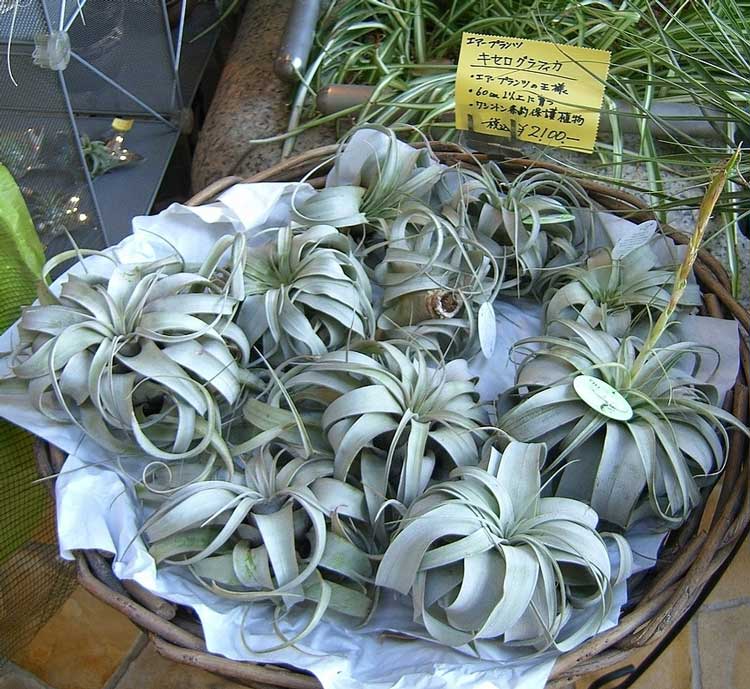
Tillandsia xerographica (*)
Classification System: APG IV
Superregnum: Eukaryota
Regnum: Plantae
Cladus: Angiosperms
Cladus: Monocots
Cladus: Commelinids
Ordo: Poales
Familia: Bromeliaceae
Subfamilia: Tillandsioideae
Tribus: Tillandsieae
Genus: Tillandsia
Species: Tillandsia xerographica
Name
Tillandsia xerographica Rohweder, Senckenbergiana 24: 113. 1953.
Synonyms
Heterotypic
Tillandsia kruseana Matuda, Cact. Suc. Mex. 19: 24. 1974.
Tillandsia tomasellii De Luca, Sabato & Balduzzi, Brittonia 31: 474. 1979.
Tillandsia xerographica f. variegata Moffler, J. Bromeliad Soc. 28: 166. 1978.
Distribution
Native distribution areas:
References
Rohweder, O., 1953. Senckenbergiana. Wissenschaftliche Mitteilungen der Senckenberischen Naturforschenden Gesellschaft. Frankfurt am Main 34:113, figs. 8-11, t. 1, fig. 2. 1953
Links
Govaerts, R. et al. 2019. Tillandsia xerographica in World Checklist of Selected Plant Families. The Board of Trustees of the Royal Botanic Gardens, Kew. Published on the internet. Accessed: 2019 Jul 08. Reference page.
International Plant Names Index. 2019. Tillandsia xerographica. Published online. Accessed: Jul 08 2019.
The Plant List 2013. Tillandsia xerographica in The Plant List Version 1.1. Published on the internet. Accessed: 2019 Jul 08.
Tropicos.org 2019. Tillandsia xerographica. Missouri Botanical Garden. Published on the internet. Accessed: 2019 Jul 07.
USDA, ARS, Germplasm Resources Information Network. Tillandsia xerographica in the Germplasm Resources Information Network (GRIN), U.S. Department of Agriculture Agricultural Research Service. Accessed: 08-Apr-12.
Vernacular names
English: Shirley Temple Airplant
日本語: キセログラフィカ
Tillandsia xerographica is a species of bromeliad that is native to southern Mexico, El Salvador, Guatemala and Honduras.[3] The name is derived from the Greek words ξηρός (xeros), meaning "dry", and γραφία (graphia), meaning "writing". It is included in Tillandsia subg. Tillandsia.[4]
Description
Tillandsia Xerographica
Tillandsia xerographica is a slow-growing, xerophytic epiphyte.[3] The silvery gray leaves are wide at the base and taper to a point making an attractive, sculptural rosette, 90 cm (3 ft) or more in diameter and over 90 cm (3 ft) high in flower. The inflorescence, on a thick, green stem, 150–380 mm (6–15 in) in height, densely branched. The leaf bracts are rosy red; the floral bracts are chartreuse; and the petals of the tubular flowers are red to purple and are very long lasting (months).
Habitat
Tillandsia xerographica inhabits dry forests and thorn scrub at elevations of 140 to 600 m in southern Mexico, Guatemala and El Salvador. Average temperatures in its habitat range from 22 °C – 28 °C, with relative humidity between 60% to 72% and annual precipitation between 550 and 800 mm.[3] It grows epiphytically on the highest branches, where it receive intense lighting.
Cultivars
Tillandsia 'Betty' (T. xerographica × T. brachycaulos)[5]
Tillandsia 'Fireworks' (T. xerographica × T. roland-gosselinii)[5]
Tillandsia 'Silver Queen' (T. jalisco-monticola × T. xerographica)[5]
Tillandsia 'Silverado' (T. chiapensis × T. xerographica)[5]
References
"Appendices I, II and III". CITES. 2012-04-03. Retrieved 2012-08-14.
Kew World Checklist of Selected Plant Families
García, Mygdalia; Hiram Ordóñez Chocano. "Case Study: Tillandsia xerographica" (PDF). International Expert Workshop on CITES Non-Detriment Findings. Retrieved 2012-08-14.
Isley, Paul T. Tillandsia: the World's Most Unusual Air Plants. Vol. 1. Botanical Press. p. 187.
BSI Cultivar Registry Retrieved 11 October 2009
Retrieved from "http://en.wikipedia.org/"
All text is available under the terms of the GNU Free Documentation License

